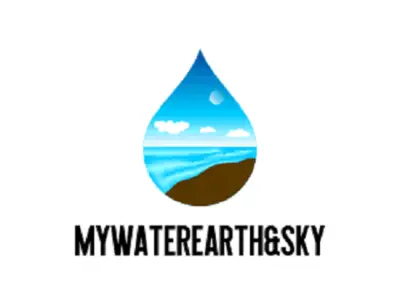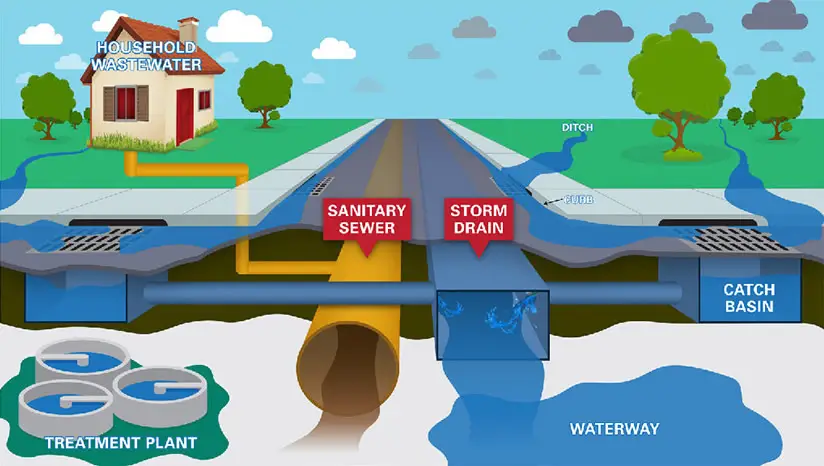In order for the proper planning and development of a community with the public’s health and protection of the environment as a goal. There are two underground systems at work to ensure the city operates. What is the difference between a Storm Water System and Sanitary Sewer System?
Storm Water System:
- Collects outside runoff rain & snowmelt
- Transports it to waterways preventing flooding-Under NPDES Permit
Sanitary Sewer System:
- Collects & Transports for treatment of domestic, commercial & industrial wastewater from inside buildings
- Normally Separate from the Storm System–Under NPDES Permit
When American cities and towns were developed infrastructure was put in place to last for 100 years or so. Each system is able to work in conjunction performing a necessary function that was genius in its time.
Storm Water Sewer
Walking down the block through your city or town you wouldn’t normally notice the Storm Drain Storm Drains along the street’s corner unless there was a problem with one filled with leaves and trash.
Storm Drains collect runoff from your local area and transport it to local streams, lakes, and wetlands keeping your town or city protected from flooding.
They also help remove the trash, litter, and other undesirable waste that ends up in areas of rivers and streams. This can help protect your city’s waterways. It’s a layer of added protection because once trash and litter from the street get into the environment it’s harder to deal with.
The Storm Drain is not made for chemicals or pollutants that can be detrimental to the environment and waterways. Oil and other fluids from cars end up in the Storm Drain but aren’t intended to. Litter and trash that end up on the ground will eventually end up in the water.
Man is the main source of blame for Storm Water Pollution and we can resolve some of it ourselves. What Is Storm Water Runoff For as long as the earth has been around rain and snow that fell to the ground were absorbed by the earth and re-entered the tributaries and waterways from where they came, completing the water cycle.
One man started building on top of the earth’s surface the natural collection and filtering of the rainwater stopped working and water that follows the path of least resistance went anywhere it wanted to. The bigger the surface the worst the problem got. This was a direct effect of modern civilization.
The answer was Storm Drains. Man-made Storm Drains take Storm Water and put it back into the local environment. Without functioning Storm Drains cities and towns would flood and stop.
What is Storm Water Management
In urban and developed areas, blacktop pavement and roofs are considered impervious surfaces that prevent rain and snow melt-off from naturally soaking into the ground. Instead, water runs rapidly into storm drains, sewer systems, and drainage ditches and can cause flooding, erosion, turbidity, storm, and infiltration into the Sewer System, along with infrastructure damage.
This water can contain harmful pollutants from motor oils to road salt that can have a huge effect on neighboring streams. Engineered stormwater design and “green infrastructure” can capture and reuse stormwater to maintain or restore natural hydrologies and give the stormwater more time by using some creative design whenever development is studied and proposed.
It is up to the managers that are in charge to come up with these planning ideas. Storm Water Systems and Storm Drains can be maintained and improved by a simple cleaning of the Drains on corners of streets that become clogged.
Large Storm Lines can be monitored and televised the replaced in sections with good planning. Relining broken or cracked lines. sealing or replacing manholes on Sanitary Sewers can stop a lot of Infiltration problems from groundwater. Some cities need NPDES permits before they can discharge stormwater to area waterways that have to be monitored and reported to State and Federal Agencies.
An NPDES permit (National Pollutant Discharge Elimination System) is typically a license for a facility to discharge a specified amount of a pollutant into receiving water under certain conditions. Detaining stormwater and removing pollutants is the primary purpose of stormwater management.
Pervious Surfaces that are porous and allow rainfall and snowmelt to soak into the soil, Gray water infrastructure, such as culverts, gutters, storm sewers, conventional piped drainage, and Blue/Green infrastructure that protect, restore, or mimic the natural water cycle, all play a part in stormwater management.
Water Sensitive Urban Design is becoming very popular in new developments and Infrastructure repair. It’s a newer approach to the old thinking of dealing with changing environments. With new ongoing problems involving water scarcity and water shortage, there is a new design that is sensitive to Storm Water Management.
This new methodology treats water more like a natural resource that can solve water problems by building natural solutions into the planning and functioning of the city as it’s being built or added afterward. In the past building, a city would cause an environmental impact on the surrounding areas of the community.
This new way of thinking harnesses the potential that water can contribute and uses in the design of the city. In a Water Sensitive Design city, natural green space and vegetation are retained in strategic areas that are developed inside the city.
These green spaces along with soil help with the natural filtering process and hydraulic control that would be found outside where the hard surfaces of the city don’t exist.
What is a Sanitary Sewer
Sanitary Sewers collect and transport domestic, commercial, and industrial Wastewater, and typically only limited amounts of stormwater and infiltrated groundwater get through the manholes and sewer lines to treatment Wastewater plants and facilities for treatment. Storm Drains and Sanitary Systems are normally independent of each other.
You cannot always tell the difference by looking at them. Generally, storm drains are outside and sewer drains are inside but not always. The Sanitary sewer system collects water from inside our homes and businesses and carries it to a treatment plant where the wastewater is cleaned before being released into rivers and streams.
Treatment plants are engineered to process a certain population and strength of sewerage and can’t accept the large amounts of Storm Water that can come from area flooding and snowmelt. Infiltration and inflow (I/I) through old sewer pipes can have a snowball effect on the whole system.
Much of the same maintenance programs that are used in Storm Water Management are used to improve Sanitary Sewer Systems. Collection pipes are repaired and or replaced by televising the lines and locating problem areas or sections.
The lines or manholes are covered or replaced to avoid rainwater or snowmelt from the ground. Controlling the amount of water that is being moved in the collection system can solve a lot of the problems faced by older towns and cities that built their infrastructure right after World War 11 or before.
Wastewater Plants are designed to treat a certain amount of flow. Process control is based on being able to control surges of Stormwater coming into the plant. As with older systems rain storms double or even triple the amount of flow coming into the Wastewater plant which ends up inundating the plant causing environmental spills and even fish kills.
Most small towns and cities can’t keep up with the enormous money and task of repairing older infrastructure. This is happening across America where aging pipes and Pump Stations are deteriorating with a lack of enough funds to replace existing infrastructure.
In the coming years especially with the emerging problem of Water Scarcity, more creative ways of dealing with these issues are going to press cities and towns to relinquish their responsibilities and hand over the keys to Private Companies which is already happening or Regionalization.
Wastewater Can be Reused First By:
- Harvesting the Graywater with a process called Phytoremediation Treatment that uses plants to naturally purify sewage
- Standard treatments-Primary-Secondary & Tertiarily
- Microfiltration
- Reverse Osmosis-(RO)
- UV light
- High Heat Systems that purify water & generate energy ..………………………………………………………………………………………………………………………. Read more
What is a Combined Sewer
Combined sewer system (CSS) collects rainwater runoff, domestic sewage, and industrial wastewater into one pipe. Under normal conditions, it transports all of the wastewater it collects to a sewage treatment plant for treatment, then discharges to a water body.
The volume of wastewater can sometimes exceed the capacity of the CSS or treatment plant (e.g., during heavy rainfall events or snowmelt). When this occurs, untreated stormwater and wastewater discharge directly to nearby streams, rivers, and other water bodies. Combined sewer overflows (CSOs) contain untreated or partially treated human and industrial waste, toxic materials, and debris as well as stormwater. according to EPA
What are the 3 Stages of Wastewater Treatment?
- Primary Stage-separates settable organic solids & inorganic material that won’t degrade
- Secondary Stage-removes suspended & soluble solids converting them to settable solids using Biological Oxidation
- Tertiary Stage-uses chemical & physical treatment to create H2O closer to potable quality ..…………………………………………………………………………………. Read more
Sanitary Sewer Overflows (SSO)
There are times when Sanitary Sewers will release sewerage because of operational problems. These releases are called Sanitary Sewer Overflows (SSOs) SSOs can contaminate local rivers and streams, causing serious water quality problems, and back-up into homes, causing property damage and threatening public health. Possible Problems that can cause SSOs can include:
- blockages,
- line breaks,
- sewer defects that allow stormwater and groundwater to overload the system,
- power failures,
- improper sewer design, and
- vandalism.
EPA estimates that there are up to 750,000 SSOs reported every year not including the sewage backups in buildings and homes like the Roto-Rotor kind that happens every day. These kinds of problems are normally investigated and are looked at seriously by EPA according to NPDES permits that are held by the municipalities or governments that can result in fines or action against the permit holders.
Having worked in the Water/Sewer Utility Grid since the 70s I’ve seen the old and the new and now it’s the crumbling infrastructure that has been coming for some time now. The Basics of Development are Storm Water and Sanitary Sewer Systems.
Pollution from these two deteriorated systems is unseen but very real. The new approaches to using Stormwater in Green Urban Design are exciting and the new technologies in Wastewater reuse are not a dream, it’s a reality that some cities are using and should be implemented now! What’s the alternative?
What is an Oxidation Pond in Wastewater Treatment?
Oxidation Ponds are large basins where wastewater is treated by natural processes using bacteria & algae at a slow rate.
Aerobic Pond-bacteria use oxygen
Anaerobic Ponds-bacteria use no oxygen
Facultative Ponds-use both bacteria
Maturation or Tertiary Ponds- aerobic bacteria used for polishing effluents ..……………………………………………………………………………………. Read more
JimGalloway Author/Editor

References:
What Is Stormwater Management and Why Is It Important?
EPA-National Pollutant Discharge Elimination System (NPDES)
